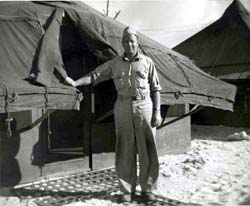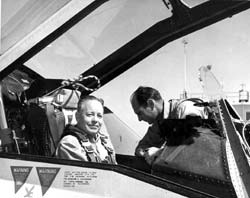|
|
|
A Rewarding Career with Vought Russ moved to the Vought side of United Aircraft in late 1940, at the request of C.J. McCarthy. He was soon asked to take over as the chief project engineer on the development of the XF4U-1 fighter for the US Navy, that became the famous WWII "Corsair". Under Russí direction, many modifications were made to the XFU-1 that made it so successful. He continued to be the chief project engineer of the In the summer of 1945, Russ became chief project engineer on Voughtís first jet fighter, the XF6U-1, nicknamed the "Pirate". In 1947, he took over as chief engineer for the new jet fighter, the XF7U-1, the "Cutlass" The building of this aircraft in the experimental department was under his control as he was appointed Chief of Experimental Manufacturing and Flight Test operations. He was also responsible for moving those departments from Connecticut to Grand Prairie in 1948. In 1952, Russ became Assistant Chief Engineer Aircraft Development. He put together and headed a design team to win the competition for a new Navy Supersonic fighter. This successful record breaking F8U-1, "Crusader", built from 1955 to 1970, won the Collier In late 1958, Russ was made Director of Engineering, over all programs, aircraft and missiles. In August 1959, he became General Manager of the new Astronautics Division and in 1960 was promoted to Vice President, General Manager of the Chance Vought Astronautics Division. He was instrumental in convincing NASA that Vought should take over the complete design, management, construction and launch activities for the four stage rocket launch Scout vehicle, and in securing the construction of the first stage propulsion system for the Saturn I trial test system for Apollo. Another program of the division was "Mallar", Manned Lunar Landing and Return, which later became accepted by NASA as the basis for the Apollo program, and the LEM, Lunar Excursion Module. Other programs included the "Dynosaur", manned space flight program for the Air Force in 1960-61; research on EVA, Extra Vehicular Activity, back packs astronauts use; "carbon carbon" research material which became the foundation that led to Vought making the leading edge and nose cone for the Space Shuttle to withstand the high temperatures. In 1961, Russ became the Vice President and General Manager of the LTV Astronautics Division. At that time, projects from the Temco side were taken over as well. In 1963, Russ played a role in helping Vought win the competitive bid for the new Navy light weight attack aircraft, the A-7. In February 1964, he was made Vice President, General Manager, of the Aeronautics Division, which was the equivalent of being President of the division as later heads were called. Programs during his administration included the production of the A-7 series of aircraft, also during the Vietnam War period; the XC-142 VSTOL; the SLAM, Supersonic Low Altitude Missile, program; competition for the VFX and for the S-3A; and the winning of subcontracting for a large amount of structural work for the Boeing 747. In 1965, LTV created the LTV Aerospace Corporation. Russ was appointed to the Board of Directors and served from 1965 to 1973. In 1969, he became Senior Vice President, Technical, for all LTV Aerospace activities. He formally retired January 1, 1972 but continued to work as a consultant, performing his last major program for Vought in 1984. Russ died October 28, 1986. Russ was married to Dot for 56 years and they had three children.
A Rewarding Career with Vought Other Prestigious Positions and Awards
|

 Corsair family of airplanes from about January 1941 until 1945. In early 1943, Russ witnessed the first test of an F4U aboard an aircraft carrier. In October 1944, Russ and Paul Baker went to the South Pacific as naval technicians. They advised operating personnel on new programs on the Corsair, on maintenance, and learned first hand of operations.
Corsair family of airplanes from about January 1941 until 1945. In early 1943, Russ witnessed the first test of an F4U aboard an aircraft carrier. In October 1944, Russ and Paul Baker went to the South Pacific as naval technicians. They advised operating personnel on new programs on the Corsair, on maintenance, and learned first hand of operations.
 Trophy for outstanding design. It also won the Thompson trophy for the highest speed of any military aircraft in the world. The F8U-1P , photo recognizance version, was the airplane that took the famous pictures flying over Cuba at the time of the Cuban missile crisis. It was also the outstanding fighter of the Vietnam War. A small scale gold plated model of the F8U was awarded by Vought through its President, Fred Detweiler to each of the following: to Russ for designing the F8U-1; to Lyman Josephs, his project engineer and to John Konrad, chief pilot. The patent for the F8U Crusader was issued to Russ Clark, and to Lyman Josephs and Conrad Lau who assisted him in the design.
Trophy for outstanding design. It also won the Thompson trophy for the highest speed of any military aircraft in the world. The F8U-1P , photo recognizance version, was the airplane that took the famous pictures flying over Cuba at the time of the Cuban missile crisis. It was also the outstanding fighter of the Vietnam War. A small scale gold plated model of the F8U was awarded by Vought through its President, Fred Detweiler to each of the following: to Russ for designing the F8U-1; to Lyman Josephs, his project engineer and to John Konrad, chief pilot. The patent for the F8U Crusader was issued to Russ Clark, and to Lyman Josephs and Conrad Lau who assisted him in the design.